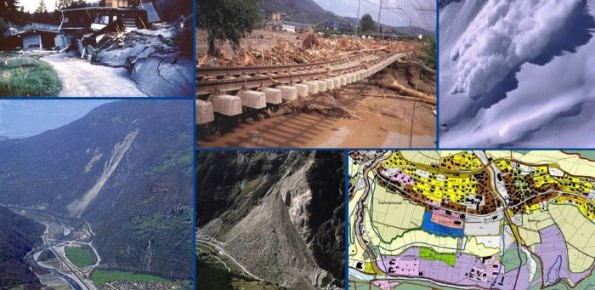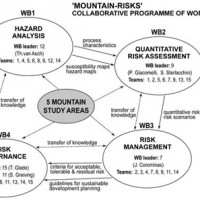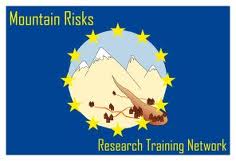Mountain Risks: from prediction to management and governance

Background
The observed increase in disastrous events over the last decades, associated with a low perception of risk by the communities involved, along with the lack of efficient, socially accepted and environmentally sound remedial measures are amongst the motivation behind this research project. The adaptation of a combined multi-risk-oriented analysis, in which the investigations focus more on the interdependence of events rather than on single event, is absolutely necessary. In addition the effects of land use changes have to be taken into account not only within the risk analysis, but also in the planning strategies. The Mountain Risks Project developed an advance understanding of how mountain hydro-geomorphological processes behave and applied this knowledge to long-term cohabitation with such hazards.
Purpose
The proposed network intended to develop an advanced understanding of how mountain hydro-geomorphological processes behave and to apply this understanding to living with such hazards in the long-term. The observed increase in disastrous events over the last decade, associated with a low perception of risk by the communities involved, along with the lack of efficient, socially accepted and environmentally sound remedial measures are amongst the motivations behind this research. Considering such challenges, it is important to continue to develop methods for assessing quantitative risk, as well as progress innovative research, knowledge sharing and education, which in turn provides support for practitioners to produce a comprehensive risk management and prevention policy.
Methods
MOUNTAIN-RISKS network has strengthened and expanded the collaboration between the teams in a Collaborative Programme of Work (CPW) associating state-of-the-art experimental, methodological and computational advances, as well as risk management strategies. Its CPW has been structured along four main Working Blocks (WB): WB1: Mountain hazard analysis; WB2: Consequence of hazard, vulnerability analysis and quantitative risk assessment, WB3: Risk management and, WB4: Risk governance.
Results
MOUNTAIN-RISKS network offered a high-level training, teaching and research in the field of hazard and risk management to European young scientists, who could find employment in European academic research centres, engineering and environmental private companies, regional geological services, governmental organisations, or International agencies. The network was able to overcome the fragmentation of the research on mountain processes by using the complementary expertise of 12 excellent European teams in the fields of natural, social, economic, legal, engineering and information sciences. The primary objective was to train individuals to become outstanding scientists in the field of mountain risks. Scientific and technological excellence was promoted by the Network within a hazard and risk framework by organizing multi-disciplinary high-level schools, workshops, and conferences
Products
Four Intensive Courses (of 4-5 days) have been organised in the mountain study areas. Senior scientists and young researchers meet together also local stakeholders, administration officers and representatives from the civil protection.
Six topic Workshops (of 2-3 days) have been organised to explore, in depth, a limited number of related tasks to the work programme. These meetings were being ‘brainstorming’ events that provided an explicit network goal in a key area of the research programme. MOUNTAIN-RISKS network contributed to overcome the fragmentation of the research on mountain natural processes by using the complementary expertise of European teams in the fields of geomorphology, geology, engineering geology, civil engineering, forest engineering, geography, economy and land use planning, for predicting mountain hazard and managing associated risk. In this sense the network facilitated the collaboration between several training centres, research centres and consulting companies with experts of different mountain processes, different backgrounds, playing different roles in risk management (researchers, technicians-practitioners, consulting companies, administrations, politicians, population representatives), and working in different socio-economic, legal and environmental contexts. In so doing, the project made the risk governance concept internal.
Conclusions
MOUNTAIN-RISKS has contributed to open up of career opportunities to young researchers because a great importance has been paid to young researchers working in a highly composite and diverse fields and being exposed to the full variety of ideas, tools and techniques that were present in the network. MOUNTAIN-RISKS multidisciplinary network has stimulated all researchers involved towards a sounder knowledge of all the aspects within mountain risks. The project provided to the young researchers a modern ‘knowledge-based’ requires now by the modern society, and strengthened the compatibility within the actual scientific job market. MOUNTAIN-RISKS young researchers have now skills beyond his or her ‘hyper-specialisation’ that typically results from a standard doctoral education.





